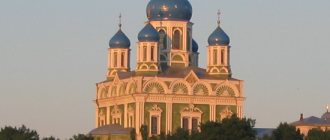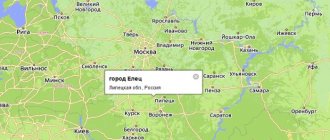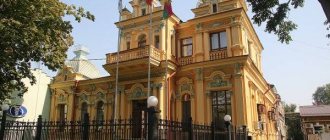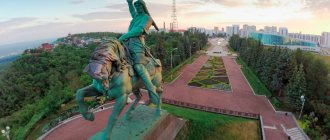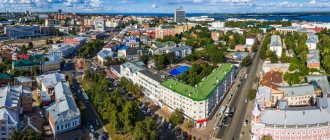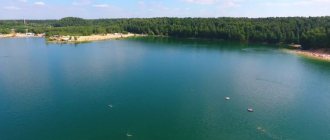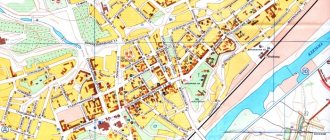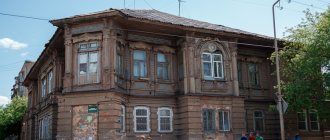Photo: Lytkarino City Portal
Rostec State Corporation is one of the largest industrial companies in Russia. Today the Corporation unites hundreds of organizations located in many cities of our country. Rostec enterprises are often city-forming, and some Russian cities have gained worldwide fame thanks to the Corporation’s developments. In the section “Travel with Rostec” we talk about the cities in which our enterprises are located. We have already visited Samara, Zhukovsky, Perm and Tula, and today we are going to Lytkarino near Moscow.
At first glance, this small town on the banks of the Moscow River, surrounded by pine forests, cannot surprise you with anything. But it was here that they made a mirror for the world’s largest telescope, rocket engines for delivering lunar rovers to the Moon, and also started the engine of the Su-57 fighter for the first time.
Historical and Local Lore Museum
The gallery was created by a group of active citizens in 1976, and its exhibition was assembled from their gifts and collected documents on the history of the city. The museum is located in the former estate of the Chernyshev princes, which was built in 1880.
The manor building, built at the beginning of the 19th century, was rebuilt in 1880 in the Italian style. Today, the museum's exhibition includes more than 30 thousand exhibits, including objects of archaeology, folk and noble life, numismatics, archival documents and photographs.
Location: 7th block - 6.
Sights of Lytkarino
+Add attractions Lytkarino » Attractions
Nowadays, educational institutions have been created in the city of Lytkarino, which are a factor attracting young people to the city. The state regional Moscow College of Technology, Entrepreneurship and Economics and the Lytkarinsky Music School are located here.
The city has created a centralized library system, which includes 5 libraries located in different areas of the city. There is a Central City Library and a Central City Library for children, a city library, which is located in the Mir Palace of Culture and a city library for children in the Mir Palace of Culture. The city also houses the Petrovskaya Library for children and youth and publishes the printed edition Lytkarinskie Vesti. There is a local history city museum in Lytkarino, the exhibition of which tells about the history of the city and the history of the development of production in the city.
One of the attractions of Lytkarino is a quarry in which quartz sand was previously mined. After the closure of this quarry, there is an artificial lake here, which is a favorite vacation spot for the townspeople. Fans of mountain biking and various extreme sports come to the quarry. Several trails have been created here for beginners and professional athletes, and professional competitions among cyclists are held.
One of the city's attractions is the Church of the Holy Apostles Peter and Paul in the Petrovsky district. The city is also home to the famous Lytkarino estate. The complex of this estate includes the House - the estate of the merchant Zotov, which later became the house of Prince Chernyshev, it was built in 1880. The building of this estate today houses the Lytkarinsky Museum of History and Local Lore. The estate preserves the brick two-story People's House, which was built in 1846 and was the first stone building built in the city of Lytkarino. In 2012, a monument to Alexander Ivanovich Chernyshev was erected on the territory of the estate. The city has preserved an ancient complex of buildings from the village of Lytkarino, in which an architectural museum has been created. A monument of regional and federal significance of the second half of the 19th century is the famous house with the shop of the merchant Goryunov.
In the northern part of the city in the Petrovsky microdistrict there is the Petrovskoye estate. Since 1680, the belfry, which was built by the owner of the village Miloslavsky, and the tented St. Nicholas Church have been preserved here. In 1798, the owner of the village, factory owner Demidov, built the Peter and Paul Church in the classicist style, which has survived to this day. After the fire that happened in 1959, the house, built at the end of the 18th century in which the merchants Baryatinsky, Chernyshev and Demidov lived at different times, was rebuilt and restored. The terraced landscape park in Lytkarino has survived to this day in satisfactory condition. In the southern part of Lytkarino, ancient buildings of the former village of Turaevo have been preserved. In the city there is the Church of the Nativity of the Blessed Virgin Mary, which was built in 1907 and today belongs to the Old Believer community, which belongs to the Belokrinitsensky consent. This community was formed more than 370 years ago. The Church of the Nativity of the Blessed Virgin Mary is a monument of architecture and urban planning.
The city of Lytkarino is known for its fellow countrymen who were born and lived in it in one year or another. The famous lead singer of the Lyube group Nikolai Rastorguev and the football player who played for Moscow Spartak Valery Pavlovich Gladilin were born here. In 1976, the famous rock musician, lead singer of the group Kipelov Andrei Sergeevich Golovanov and actress who works at the Sovremennik Theater Ulyana Lapteva were born here. In 1979, the master of Russian billiards Evgeniy Evgenievich Stalev and six-time Russian champion in the game of bridge Larisa Ivanovna Panina were born in Lytkarino.
Lytkarinsky Museum of History and Local Lore (0
voices)
Lytkarino Museum of History and Local Lore Address: Russia, Moscow region, Lytkarino, kv.
7th, no. 6 Phone E-mail: unknown Website: www.museum.ru Found an error?
No reviews
Sundial at the Lytkarino estate
In 2012, a unique sundial was restored on the territory of the estate. When recreating them, they used the original stone slab and pedestal for the clock, which were made by local stonemasons.
There are three time scales engraved on the watch dial. The first scale shows the time on the meridian of the Chernyshev house in Rome, the other shows the time on the meridian of the estate, and the third shows standard time in the local time zone.
Church of the Nativity of the Virgin Mary
This wooden, Old Believer shrine was erected in 1907. The temple has a semicircular apse made of red brick, as well as a pointed turret, which is crowned with an eight-pointed cross.
The tallest building here is the bell tower, located above the entrance portal of the cathedral. It has one tier and is made of brick. The faceted tent of the bell tower is decorated with wooden trim. The uniqueness of the tent lies in the fact that it consists of brick elements of various shapes: rectangular, triangular, bead-shaped and arched lintels. Next to the temple there is a burial ground with carved tombstones.
Church of St. Nicholas the Wonderworker
It is located on the territory of the Petrovskoye estate and was erected at the end of the 17th century. The tented church consists of four with two rows of windows, which are topped with an octagon and a tent. On the eastern side of the cathedral there is an apse, and above the western side of the refectory there is a belfry. In the 30s of the last century, the temple was badly damaged, but in the 70s its restoration began.
Location: 6th microdistrict, st. 1.
Space optics from Lytkarino
The history of the Lytkarinsky optical glass plant did not end there, but only began. Today this city-forming enterprise is part of the Rostec Shvabe holding. LZOS is a leading Russian manufacturer of optical glass and fiberglass, large-sized astronomical and space mirrors, space lenses, various optical parts and instruments. It is thanks to the Lytkarino plant that Russia is one of the world's three largest suppliers of optical glass. In addition to the production of optical materials, the plant is a leader in the production of large-sized astronomical optics - LZOS produces about a third of the entire global market for large-sized optics.
Large mirrors with a diameter of several meters began to be manufactured at LZOS back in the 1980s. This is a key part of any telescope, and perhaps its most complex part. LZOS specialists have developed a unique technology that makes it possible to produce a mirror weighing several tens of tons and process it with nanometer precision.
Thus, in Lytkarino, mirrors were produced for the most famous telescopes in the world: the Large Azimuthal Telescope (BTA), once the largest in the world, and today in Eurasia; the Chinese giant LAMOST, the second largest in Asia, the Thai telescope TNT and many other international projects.
Cathedral of Saints Peter and Paul
The church was built in the Empire style at the expense of local mining owner Grigory Demidov in 1805. During the Patriotic War of 1812, the temple was plundered by Napoleon's troops, and in the 50s of the 19th century the Chernyshev family burial vault was built here.
At the end of the 30s of the last century, the Peter and Paul Church was closed and for a long time its building was used for other purposes. The shrine was returned to believers in 1990. The restoration of the church was carried out until 2004. During the restoration of the temple, a small belfry was installed, which included 5 bells.
Location: 6th microdistrict street, building 1.
Lytkarino is a city with a long history
There are many cities around Moscow. Some of them have an interesting history and correspond in age to the capital. Others are little-known and inconspicuous. The town of Lytkarino, located near Moscow, can be considered one of these. It is not a major tourist destination like Kolomna or Dmitrov, nor is it often featured in the news.
However, Lytkarino has a long history. Like many settlements in the capital region, the first mentions of it date back to the Middle Ages. The first documentary mention of Lytkarino is recorded in the charter of the Chudov Monastery dated 1429. In the 15th-17th centuries the village was a monastery, and in this status it survived the Rurik dynasty and the Time of Troubles.
In the 18th to mid-19th centuries, the village was owned by the Zotov dynasty. Its famous representative was Nikita Zotov, the mentor of the young Peter I. At that time, the main occupation of the residents of Lytkarino was the extraction of stone for construction in a quarry in the neighboring village of Myachkovo. By the end of the 19th century, the number of quarries near Lytkarino reached five. Local stonemasons were called “Lytkars”, and the stone was used in the construction of Moscow cathedrals.
From 1852 to 1872, the village and the estate on its territory were owned by the wife of the famous participant in the War of 1812, Alexander Chernyshev, and after her death the inheritance passed to her youngest daughter. In those years, about 500 people lived in it. At the end of the 19th century, Prince Baryatinsky became the owner of Lytkarino. He owned it until the revolutionary 1917. During that period, Lytkarino became famous not only for its stone, but also for the extraction of quartz sand. It was mined at the Lytkarinsky Heights and used to make millstones for mills. They were widely known outside the city.
During the USSR, the village began to develop as an industrial center. In the mid-1930s, construction of an optical glass plant was completed there. The location for its location was not chosen by chance; quartz sand is required for this type of production. At the end of the 1930s, a village with brick houses began to be created around the plant. The nearest villages gradually began to join it.
In 1939, the settlement received the status of an urban-type settlement. On the eve of this, a club opened in it and a paved road was built that connected it with the Ryazan highway. Ten years later, a railway connection with the capital appeared. In the mid-1950s, a bus station, a canteen, a bathhouse and several blocks of permanent houses appeared in the village. Between 1939 and 1959 the population increased fourfold, from 6 to 25 thousand.
Lytkarino was granted city status relatively late - in 1957. From that moment on, the construction of five-story buildings began, and a recreation center and aviation industry enterprises also appeared. By the end of the 1980s, the population doubled.
At the moment, Lytkarino is a good option for a short visit from Moscow as part of a day trip. Here you can visit a quarry, several churches and a mid-19th century estate that houses a local history museum.
Source
Views: 458
National Equestrian Park "Rus"
It was opened in 2013 in the village of Orlovo, 3 km from Lytkarino. The park provides horse riding lessons and training for athletes. There is also a cafe and a playground for little visitors with a carousel.
In winter, the park has a skating rink. There is also a fishing village where you can fish and also go boating. On the territory of “Rus” there is a chapel, not far from which there is a memorial pedestal to Saints Peter and Fevronia.
Where engines are taught to fly
The development of Lytkarino is connected, among other things, with the establishment here of significant domestic engine-building enterprises. The city is home to the CIAM Research and Testing Center, Europe's largest experimental complex of aircraft engines, the Turaevsky Machine-Building Design Bureau "Soyuz", where liquid rocket engines for spacecraft are created, as well as the Lytkarinsky Machine-Building Plant (LMZ).
The company was founded in 1955 as a branch of pilot plant No. 165 (now the A. Lyulka Design Bureau - a branch of UEC-UMPO). At the plant in Lytkarino, components and parts were manufactured, and several generations of aircraft engines of the AL brand (Arkhip Lyulka) were tested. Nowadays, the Lytkarinsky Machine-Building Plant is also a branch of UEC-UMPO. This is a testing base for all experimental engines produced at UEC-UMPO. Here the engines literally learn to fly - after testing in Lytkarino, the engines go directly to airplanes.
For example, in 2014, state tests of the 117S product, an engine for the Su-35S 4++ generation fighter, took place here. In November 2016, the first ground launch of the engine for the fifth generation fighter Su-57 took place at LMZ. In recent years, the plant has carried out a large-scale reconstruction of the testing station, and completed the construction of a new stand where prototypes of promising aircraft engines will be tested.
Estate "Petrovskoe"
The estate was developed at the end of the 18th century by Prince Chernyshev, who bought it for his son. Somewhat later, it was slightly rebuilt: a system of ponds appeared on the slope, which went down to the Moscow River basin, and a beautiful park area was also developed. The estate is a two-story house in a classic style.
What made the main building unique was its round belvedere. In the 30s of the last century, a fire occurred in the estate, destroying the second floor of the building. It was restored in the 50s, but is very different in style from the original.
Location: 6th microdistrict, building - 6.
Central Park of Culture and Leisure
The park territory is located right in the city center on an area of 4 hectares. It was founded in 1961 at the building of the local Palace of Culture. A summer stage and a rotunda were built here. However, for a long period of time no one was engaged in landscaping the park area.
Only in 2011, a new rotunda was built, the pedestrian paths were covered with paving slabs, many benches were installed for visitors to rest, as well as about 70 lanterns in the style of the Pushkin era. There are a large number of attractions for young visitors. The park hosts concerts and sporting events, and in winter there is an ice skating rink.
Lytkarinsky quarry
The history of this quarry begins in the 30s of the last century, when an optical glass factory was opened on the territory of the Tomilino Forest Park. The quarry was dug to extract quartz sand necessary for the production. But in the 7 years, production was stopped, and over time the quarry filled with water. These days, the quarry is very popular as a recreation area.
Volkusha quarry
This landmark of Lytkarino attracts lovers of beach holidays and mountain biking in summer.
Sand has long been mined in the Lytkarino quarries for foundry work, reconstruction of river sluice structures and glass production. In the early 1970s, development of the field ended. The quarry quickly filled with clean spring water, and trees were planted on its banks. Now “Volkusha” is a beautiful lake with well-maintained sandy beaches. This is a wonderful place to relax by the water. In summer you can go mountain biking along the steep banks of the quarry, and in winter you can go skiing.
